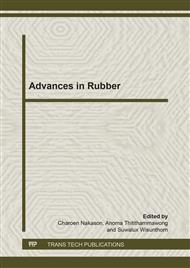p.113
p.117
p.122
p.127
p.131
p.135
p.140
p.144
p.149
Comparative Study of NR/BR/PP and NR/NBR/PP Ternary Blends for High Abrasion Resistant Thermoplastic Vulcanizates
Abstract:
High abrasion thermoplastic vulcanizates (TPVs) based on natural rubber (NR)/butadiene rubber (BR)/polypropylene (PP) and NR/acrylonitrile butadiene rubber (NBR)/PP were prepared using melt blending method. The rubber blends of 40/60 NR/BR and 40/60 NR/NBR were firstly prepared to investigate their mechanical and wear-resistant properties. The results indicated that the abrasion resistance of NR/BR blend was much higher than that of the NR/NBR blend, but the tensile strength and elongation at break were lower. TPVs made of NR/BR/PP and NR/NBR/PP blends were then prepared by melt-mixing the rubber blends (i.e., NR/BR or NR/NBR) and PP with composition of rubber to plastic of 60/40. It was found that the NR/BR/PP TPV showed higher strength and abrasion resistance when compared with the NR/NBR/PP TPV due to smaller domain of vulcanized rubber particles. The present study also suggested that the abrasion resistance of NR/BR/PP TPV was slightly lower than that of nylon 6.
Info:
Periodical:
Pages:
131-134
Citation:
Online since:
November 2013
Price:
Сopyright:
© 2014 Trans Tech Publications Ltd. All Rights Reserved
Share:
Citation:


